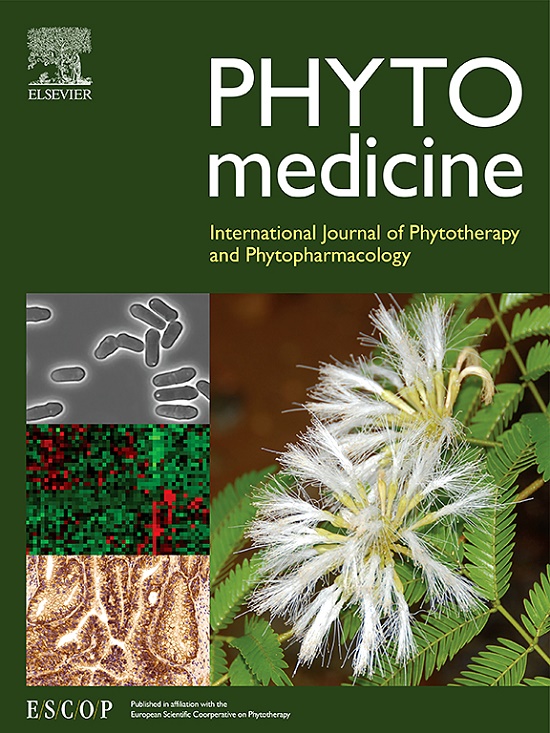Dual role of Baimao-Longdan-Congrong-Fang in inhibiting Staphylococcus aureus virulence factors and regulating TNF-α/TNFR1/NF-κB/MMP9 axis
IF 6.7
1区 医学
Q1 CHEMISTRY, MEDICINAL
引用次数: 0
Abstract
Background
Baimao-Longdan-Congrong-Fang (BLCF), a traditional Chinese herbal formula described in the Taiping Shenghui Fang (998 AD), consists of medicinal plants with heat-clearing and tonifying properties. BLCF has a promise as a treatment for Staphylococcus aureus (S. aureus) pneumonia, according to its historical use and current pharmacological research.
Purpose
In this study, the inhibitory effects of BLCF on S. aureus virulence factors were evaluated in vitro, and its mechanisms of action were investigated in a methicillin-resistant S. aureus (MRSA) pneumonia mouse model.
Methods
The inhibitory effect of BLCF on S. aureus virulence factors, including sortase A (SrtA) and α-hemolysin (Hla), was investigated by fluorescence resonance energy transfer (FRET) and hemolysis assays. A C57BL/6J mouse model of MRSA pneumonia was employed to evaluate its therapeutic efficacy. Accordingly, an integrated strategy of medicinal chemistry, network pharmacology analysis, GEO database analysis, bioinformatics, molecular docking, molecular dynamics simulation, GeneMANIA-based functional association (GMFA), and GSEA was used to identify and illustrate potential therapeutic targets and mechanisms. Subsequently, the mechanistic results were confirmed by Western blot analysis and RT-qPCR.
Results
While BLCF exhibited weak inhibitory activity against S. aureus USA300, Newman, and SA37 strains, it significantly suppressed SrtA-related virulence functions without affecting bacterial growth. FRET and hemolysis assays confirmed that BLCF inhibited SrtA activity (IC50 = 1.25 mg/mL) while decreasing hemolytic activity. Furthermore, BLCF protected mice from MRSA infection, increasing their survival rates. Bioinformatics analysis identified 26 active compounds and 2 hub genes (Tnf and Mmp9) that were associated with 5 types of immune cell, including activated CD4 T cells, myeloid-derived suppressor cells, activated dendritic cells, macrophages, and mast cells. Molecular docking revealed 3 active compounds (isoacteoside, verbascoside, and echinacoside) that exhibited strong binding affinities to TNF, MMP9, and SrtA. Molecular dynamics simulations validated the stable interactions between isoacteoside and the target proteins, yielding binding energies of −136.76 ± 8.83 kJ/mol, −174.98 ± 14.89 kJ/mol, and −186.34 ± 9.06 kJ/mol, respectively. The therapeutic effect of BLCF was closely linked to the NF-κB signaling pathway, as revealed by GMFA and GSEA analyses. In vivo, BLCF reduced lung bacterial load, improved the wet/dry ratio, and decreased inflammatory cytokines, thereby enhancing lung histopathology through modulation of the TNF-α/TNFR1/NF-κB/MMP9 axis.
Conclusions
BLCF can effectively treat MRSA pneumonia in mice by inhibiting SrtA activity, decreasing hemolytic activity, and regulating the TNF-α/TNFR1/NF-κB/MMP9 axis. These findings suggest BLCF, a traditional herbal formula, as a promising novel therapeutic approach to treat pneumonia.

求助全文
约1分钟内获得全文
求助全文
来源期刊

Phytomedicine
医学-药学
CiteScore
10.30
自引率
5.10%
发文量
670
审稿时长
91 days
期刊介绍:
Phytomedicine is a therapy-oriented journal that publishes innovative studies on the efficacy, safety, quality, and mechanisms of action of specified plant extracts, phytopharmaceuticals, and their isolated constituents. This includes clinical, pharmacological, pharmacokinetic, and toxicological studies of herbal medicinal products, preparations, and purified compounds with defined and consistent quality, ensuring reproducible pharmacological activity. Founded in 1994, Phytomedicine aims to focus and stimulate research in this field and establish internationally accepted scientific standards for pharmacological studies, proof of clinical efficacy, and safety of phytomedicines.
 求助内容:
求助内容: 应助结果提醒方式:
应助结果提醒方式:


